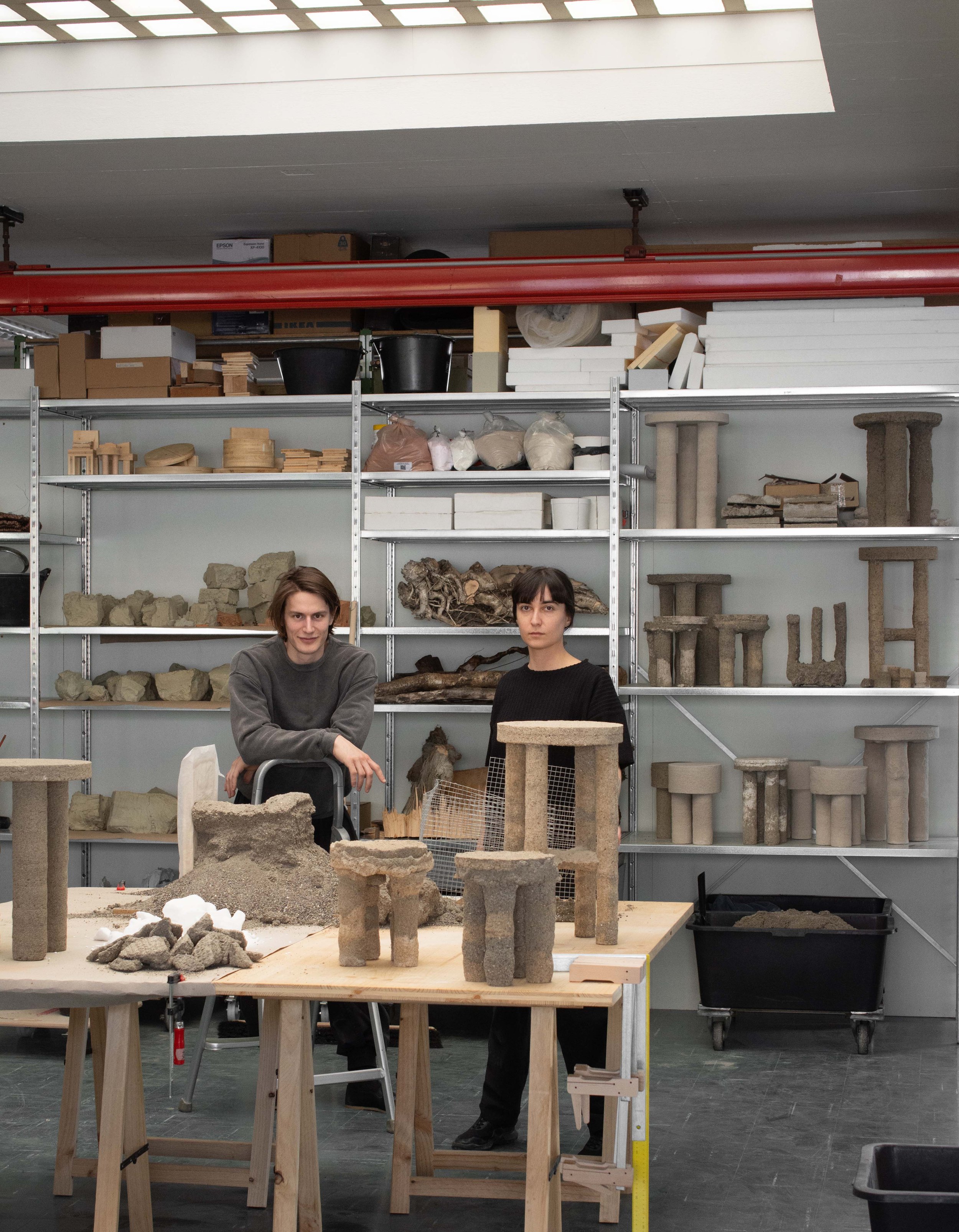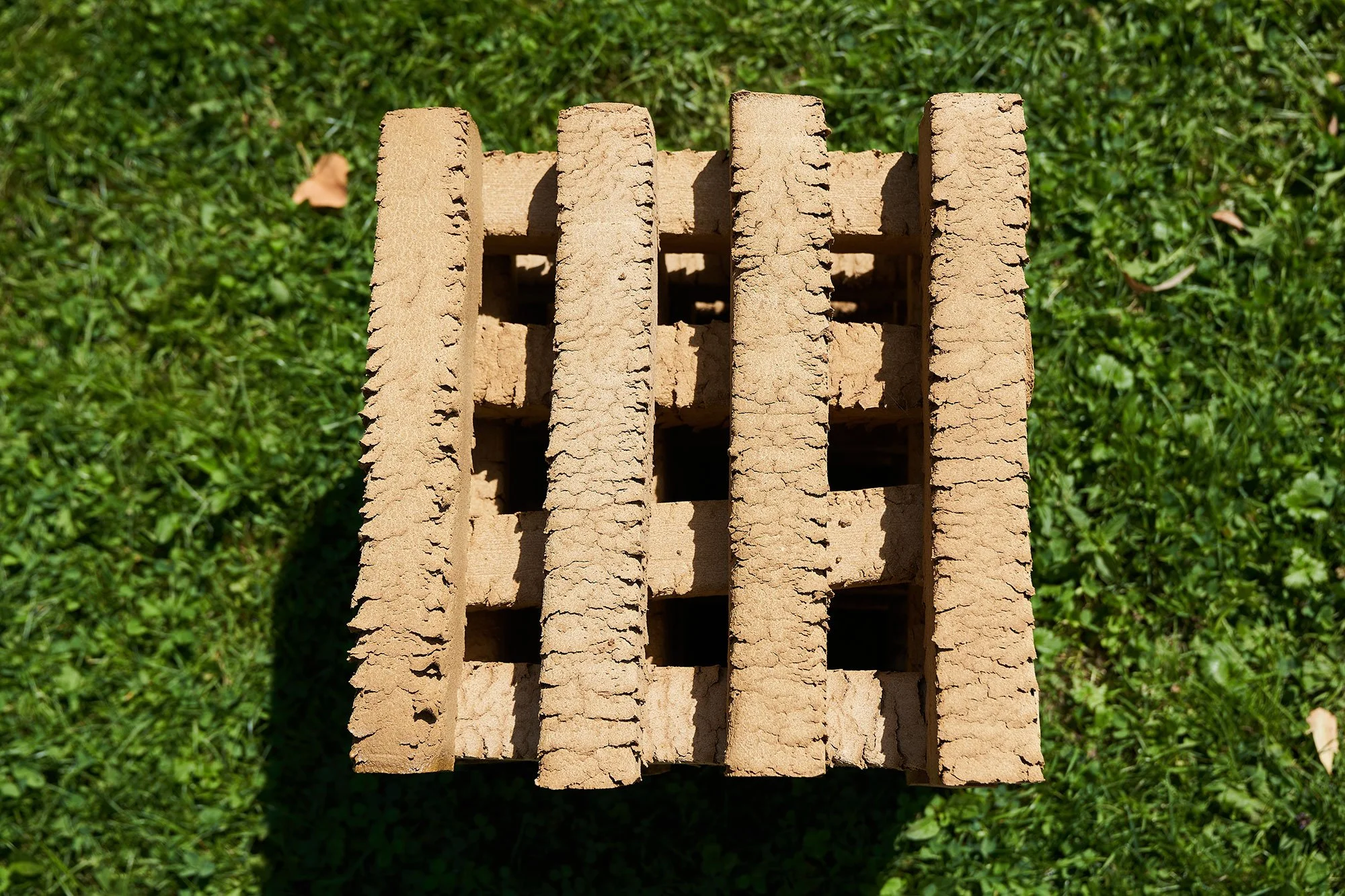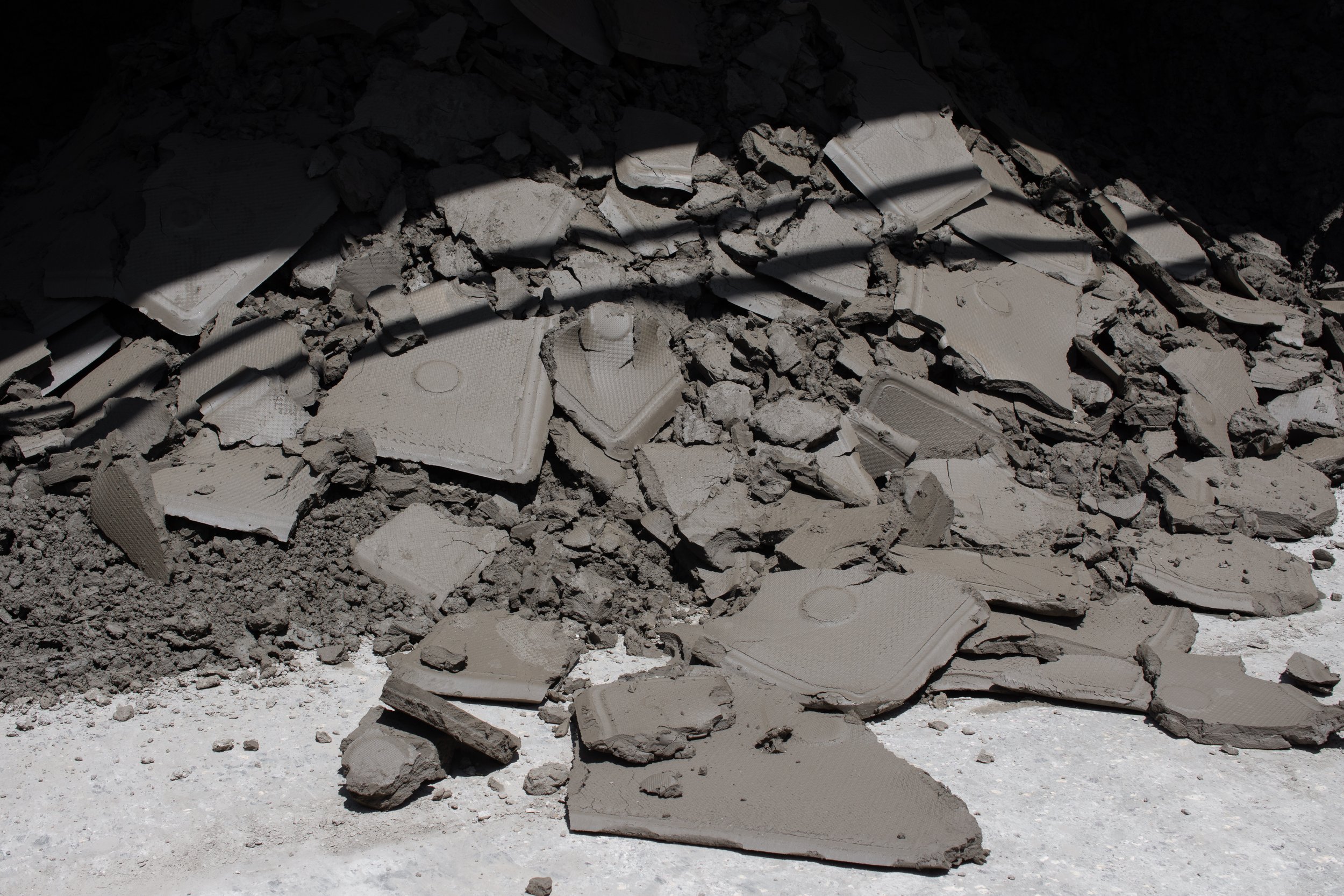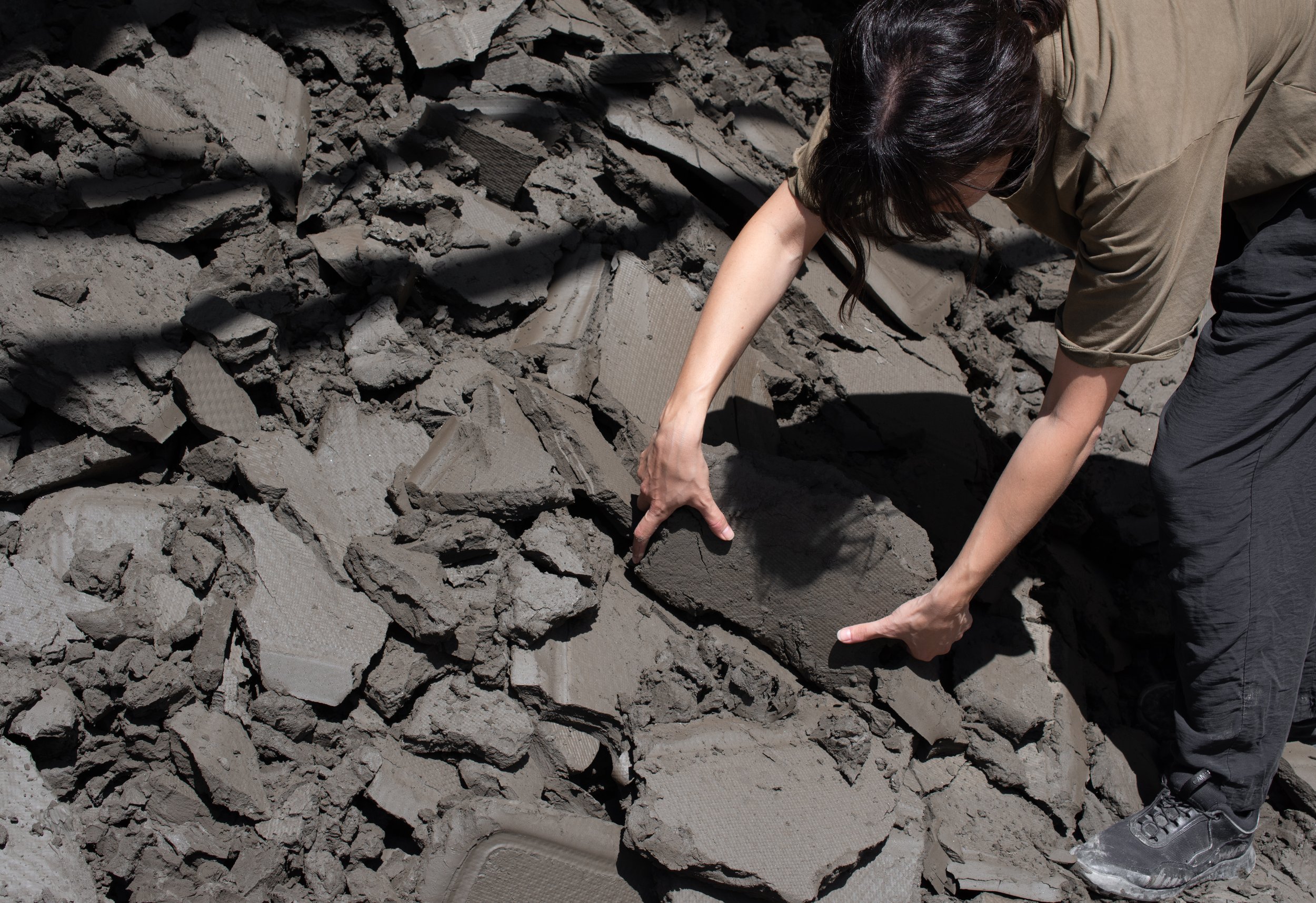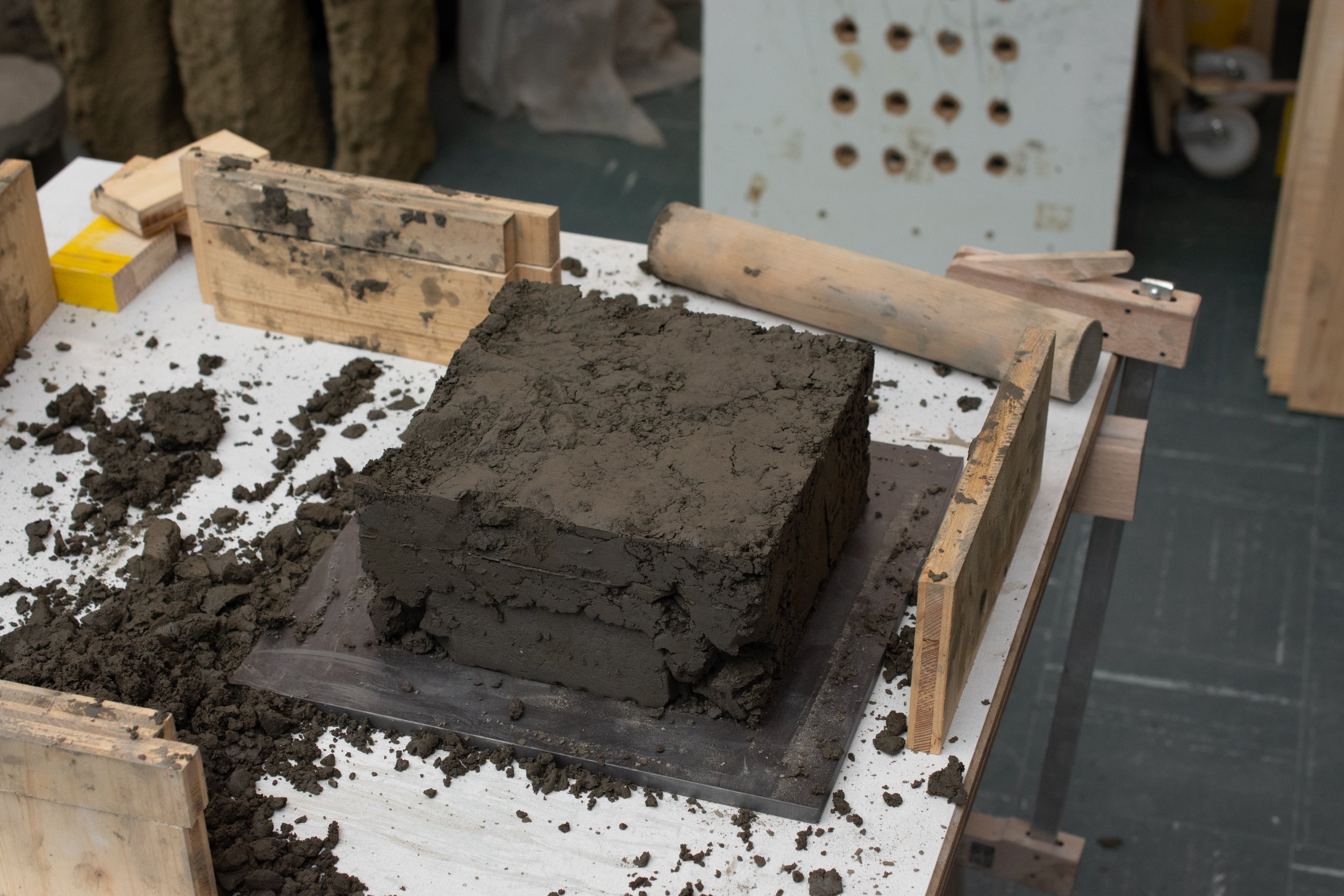Liminal Sediments –Studio Eidola
Liminal Sediments
Studio Eidola
Die Installation zeigt potenzielle Verwendungsmöglichkeiten von Schotterabfällen aus Steinbrüchen auf, deren Eigenschaften und Merkmale im Vorfeld erforscht wurden. Sie stellt die traditionelle Vorstellung davon, was eine wertvolle Ressource ist, in Frage und regt einen Diskurs über die Verbindung zwischen menschlicher Kultur und Umwelt an.
«Liminal Sediments» setzt sich mit dem Begriff der Liminalität auseinander – dem Zustand des Dazwischenseins. Unter Verwendung von weggeworfenen Steinbruchabfällen erforscht das Projekt die Übergangsphasen im Materialentwicklungsprozess. Statt sich bloss auf das Endergebnis zu konzentrieren, macht es auf die Einzigartigkeit und das Potenzial jeder Phase aufmerksam. Es hebt hervor, wie dieselbe Grundlage zu unterschiedlichen Erscheinungsformen eines Materials führen kann und unterstreicht die Vielfalt der Möglichkeiten.
«Liminal Sediments» handelt vom alchemistischen Prozess der Ziegelherstellung. Dabei werden die Sinter- und Verglasungsprozesse des Materials untersucht, um die komplexen Nuancen von Temperatur und Zeit sowie die chemischen Reaktionen, die während des Brennens ablaufen, zu enthüllen. Das Projekt schafft bewusst Bedingungen, die das Gedeihen von Grenzstadien ermöglichen.
Inmitten von Ungewissheit und Mehrdeutigkeit birgt der Zustand des Dazwischenseins ein transformatives Potenzial. Er ermutigt dazu, den Prozess des Werdens anzunehmen, den Wert des Lernens aus jeder Phase zu erkennen und die Entwicklungsschichten, die sich entfalten, zu würdigen. Indem die Installation konventionelle Wertvorstellungen in Frage stellt, ermutigt sie zur Erforschung alternativer Perspektiven. Sie lädt das Publikum dazu ein, gängige Paradigmen sowie den inhärenten Wert von Materialien und die Bedeutung, die wir ihnen zuweisen, zu hinterfragen.
The installation highlights potential uses for gravel quarry waste, the properties and characteristics of which have been researched in advance. It challenges the traditional notion of what constitutes a valuable resource and stimulates a discourse on the connection between human culture and the environment.
“Liminal Sediments” delves into the concept of liminality – the state of being in-between. By utilizing discarded quarry waste, the project explores the transitional phases within the process of material development. Rather than solely focusing on the final outcome, it draws attention to the uniqueness and potential inherent in each phase. It highlights how the same foundation can lead to diverse manifestations of a material, showcasing the multitude of possibilities.
“Liminal Sediments” centers around the alchemical process of brick making. It delves into the sintering and vitrification processes of the material, unveiling the intricate nuances of temperature, time, and the chemical reactions that occur during firing. The project intentionally creates conditions that foster the flourishing of boundary stages.
Amidst uncertainty and ambiguity, the state of being in-between holds transformative potential. It encourages embracing the process of becoming, recognizing the value of learning from each stage, and appreciating the unfolding layers of development. By challenging conventional notions of value, the installation prompts exploration of alternative perspectives. It invites the audience to question established paradigms and reevaluate the inherent value of materials and the meaning we attribute to them.
Curators’ Comment
Denizay Apusoglu and Jonas Kissling sind zwei Forschende, die ergebnisoffen Eigenschaften und Zustände von mineralischen Rohstoffen untersuchen und daraus Prozesse ableiten, um neue Materialien und Einsatzgebiete zu gewinnen. Mich fasziniert, wie das Duo sich mit viel Leidenschaft diesen Stoffen widmet und mit welcher Ausdauer sie möglichem Potential auf der Spur sind. Bemerkenswert ist nicht nur die Forschung, sondern auch der gestalterische Umgang mit dem Ergebnis. Sie vermögen durch die Formgebung das Material in den Fokus zu setzen und potenzielle Nutzer:innen und Produktionen dafür zu gewinnen. Nicht nur der Ursprung des Materials ist ein steiniger, auch der Weg, den Studio Eidola einschlägt, ist unbequem und benötigt viel Mut. Dieser wird sich auszahlen, denn Restmaterialien aus der Kiesgewinnung können zukünftig eingesetzt werden. Dadurch reduziert sich der Impact auf unsere Umwelt auf markante Weise. (Andreas Saxer)
Denizay Apusoglu and Jonas Kissling are two researchers who explore the properties and states of mineral raw materials without preconceived notions, deriving processes to discover new materials and applications. I am fascinated by how this duo passionately dedicates themselves to these substances and tirelessly pursues potential possibilities. Their research is remarkable, but so is their creative approach to the results. Through their design, they manage to bring the material into focus and engage potential users and productions. The path Studio Eidola takes is not only challenging, much like the origin of the material, but it also requires a great deal of courage. However, this will pay off, as residual materials from gravel extraction can be utilized in the future, significantly reducing the impact on our environment. (Andreas Saxer)
Fragebogen Questionary
Wie sieht Euer Arbeitsplatz aus?
Definitiv etwas chaotisch. Ein Raum voll Stapel von Materialien und Prototypen, an denen wir arbeiten.
Welche Themen beschäftigen Euch in Eurer Arbeit?
Neubewertung von übersehenen und weggeworfenen mineralischen Materialien, die Bedeutung der Beziehungen zwischen Menschen und Material durch zyklisches Denken, Ästhetik der natürlichen Prozesse, die die Landschaft formen.
Wo findet Ihr Inspiration?
In der Landschaft, entweder natürlicher oder künstlicher Art. Manchmal in einem Steinbruch, manchmal in einem Nebenfluss oder in einem alten Meeresbecken.
Wie sieht bei Euch ein normaler Designprozess aus?
Wenn wir auf etwas stoßen, das uns fasziniert, beginnen wir in der Regel mit einer allgemeinen Recherche. Dann gehen wir auf Exkursionen, um das Thema aus erster Hand zu beobachten, diskutieren die dabei entstehenden Ideen, führen Experimente durch, um ein tieferes Verständnis der Materie zu erlangen, und konzentrieren uns schließlich auf das relevanteste Konzept, um es weiterzuentwickeln.
Welches sind Eure wichtigsten Arbeitswerkzeuge?
Unsere Hände.
What does your workplace look like?
Definitely a messy one. It is full of material piles and prototypes that we work on.
Which topics do you deal with in your work?
Revaluation of overlooked and discarded mineral materials, making sense of human-material relationships through cyclic thinking, aesthetics of the natural processes that shape the landscape.
Where do you find inspiration?
In the landscape, either natural or artificial. Sometimes in a quarry, sometimes in a tributary or in an ancient ocean basin.
What does a normal design process look like for you?
When we come across something that fascinates us, we typically begin with a general research inquiry. We then go on field trips to observe the topic firsthand, discuss the ideas that emerge, conduct experiments to gain a deeper understanding of the material, and ultimately focus on the most relevant concept to develop it further.
Which are your most important working tools?
Our hands.
Über About
Studio Eidola ist ein Zürcher Forschungs- und Designstudio, gegründet 2020 von Denizay Apusoglu und Jonas Kissling. Ihre Arbeit beginnen sie jeweils mit ergebnisoffenen Untersuchungen der Zyklen und Eigenschaften von Rohstoffen, Prozessen, die die Landschaft formen und Traditionen langjähriger Herstellungskulturen. Ihre Entdeckungen setzen sie in Objekte, Räume oder Manifeste um.
Studio Eidola is a Zurich-based research and design studio founded in 2020 by Denizay Apusoglu and Jonas Kissling. They each begin their work with open-ended investigations into the cycles and properties of raw materials, processes that shape the landscape, and traditions of long-standing manufacturing cultures. They translate their discoveries into objects, spaces, or manifestos.

